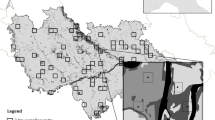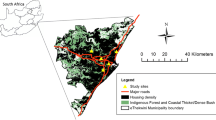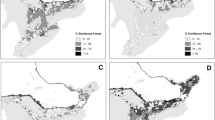Abstract
Context
Habitat loss and fragmentation may alter habitat occupancy patterns, for example through a reduction in regional abundance or in functional connectivity, which in turn may reduce the number of dispersers or their ability to prospect for territories. Yet, the relationship between landscape structure and habitat niche remains poorly known.
Objectives
We hypothesized that changes in landscape structure associated with habitat loss and fragmentation will reduce the habitat niche breadth of forest birds, either through a reduction in density-dependent spillover from optimal habitat or by impeding the colonization of patches.
Methods
We surveyed forest birds with point counts in eastern Ontario, Canada, and analyzed their response to loss and fragmentation of mature woodland. We selected 62 landscapes varying in both forest cover (15–45%) and its degree of fragmentation, and classified them into two categories (high versus low levels of loss and fragmentation). We determined the habitat niche breadth of 12 focal species as a function of 8 habitat structure variables for each landscape category.
Results
Habitat niche breadth was narrower in landscapes with high versus low levels of loss and fragmentation of forest cover. The relative occupancy of marginal habitat appeared to drive this relationship. Species sensitivity to mature forest cover had no apparent influence on relative niche breadth.
Conclusions
Regional abundance and, in turn, density-dependent spillover into suboptimal habitat appeared to be determinants of habitat niche breadth. For a given proportion of forest cover, fragmentation also appeared to alter habitat use, which could exacerbate its other negative effects unless functional connectivity is high enough to allow individuals to saturate optimal habitat.





Similar content being viewed by others
References
Aben J, Adriaensen F, Thijs KW, Pellikka P, Siljander M, Lens L, Matthysen E (2012) Effects of matrix composition and configuration on forest bird movements in a fragmented Afromontane biodiversity hotspot. Anim Conserv 15:658–668
Bélisle M, Desrochers A (2002) Gap-crossing decisions by forest birds: an empirical basis for parameterizing spatially-explicit, individual-based models. Landscape Ecol 17:219–231
Bélisle M, Desrochers A, Fortin M-J (2001) Influence of forest cover on the movements of forest birds: a homing experiment. Ecology 82:1893–1904
Betts M, Forbes G, Diamond A (2007) Thresholds in songbird occurrence in relation to landscape structure. Conserv Biol 21:1046–1058
Betts M, Forbes G, Diamond A, Taylor P (2006) Independent effects of fragmentation on forest songbirds: an organism-based approach. Ecol Appl 16:1076–1089
Betts MG, Hadley AS, Rodenhouse N, Nocera JJ (2008a) Social information trumps vegetation structure in breeding-site selection by a migrant songbird. Proc R Soc B Biol Sci 275:2257–2263
Betts MG, Hagar JC, Rivers JW, Alexander JD, McGarigal K, McComb BC (2010) Thresholds in forest bird occurrence as a function of the amount of early-seral broadleaf forest at landscape scales. Ecol Appl 20:2116–2130
Betts MG, Rodenhouse NL, Sillett TS, Doran PJ, Holmes RT (2008b) Dynamic occupancy models reveal within-breeding season movement up a habitat quality gradient by a migratory songbird. Ecography 31:592–600
Betts M, Villard M-A (2009) Landscape thresholds in species occurrence as quantitative targets in forest management: generality in space and time? Setting conservation targets for managed forest landscapes. Cambridge University Press, Cambridge, pp 185–206
Bibby CJ, Burgess ND, Hill DA, Mustoe SH (2000) Bird census techniques, 2nd edn. Academic Press, London
Biz M, Cornelius C, Metzger JP (2017) Matrix type affects movement behavior of a Neotropical understory forest bird. Persp Ecol Conserv 15:10–17
Brawn J, Robinson S (1996) Source-sink population dynamics may complicate the interpretation of long-term census data. Ecology 77:3–12
Broennimann O, Fitzpatrick M, Pearman P, Petitpierre B, Pellissier L, Yoccoz N, Thuiller W, Fortin M-J, Randin C, Zimmermann N, Graham C, Guisan A (2012) Measuring ecological niche overlap from occurrence and spatial environmental data. Glob Ecol Biogeogr 21:481–497
Buchanan ML, Askins RA, Jones CC (2016) Response of bird populations to long-term changes in local vegetation and regional forest cover. Wilson J Ornithol 128:704–718
Chalfoun AD, Schmidt KA (2012) Adaptive breeding-habitat selection: is it for the birds? Auk 129:589–599
Charbonneau NC, Fahrig L (2004) Influence of canopy cover and amount of open habitat in the surrounding landscape on proportion of alien plant species in forest sites. Ecoscience 11:278–281
Cornell KL, Donovan TM (2010a) Effects of spatial habitat heterogeneity on habitat selection and annual fecundity for a migratory forest songbird. Landscape Ecol 25:109–122
Cornell KL, Donovan TM (2010b) Scale-dependent mechanisms of habitat selection for a migratory passerine: an experimental approach. Auk 127:899–908
Cunningham MA, Johnson DH (2012) Habitat selection and ranges of tolerance: how do species differ beyond critical thresholds? Ecol Evol 2:2815–2828
Cunningham MA, Johnson DH (2016) What you find depends on where you look: responses to proximate habitat vary with landscape context. Avian Conserv Ecol 11(2):1. https://doi.org/10.5751/ACE-00865-110201
Delciellos AC, Ribeiro SE, Vieira MV (2017) Habitat fragmentation effects on fine-scale movements and space use of an opossum in the Atlantic Forest. J Mammal 98:1129–1136
Desrochers A, Renaud C, Hochachka W, Cadman M (2010) Area-sensitivity by forest songbirds: theoretical and practical implications of scale-dependency. Ecography 33:921–931
Dhondt AA (2012) Interspecific competition in birds. Oxford University Press, Oxford
Donovan T, Flather C (2002) Relationships among north American songbird trends, habitat fragmentation, and landscape occupancy. Ecol Appl 12:364–374
Drapeau P, Leduc A, McNeil R (1999) Refining the use of point counts at the scale of individual points in studies of bird-habitat relationships. J Avian Biol 30:367–382
Driscoll M, Donovan T (2004) Landscape context moderates edge effects: nesting success of Wood Thrushes in central New York. Conserv Biol 18:1330–1338
Dunford W, Freemark K (2004) Matrix matters: effects of surrounding land uses on forest birds near Ottawa, Canada. Landscape Ecol 20:497–511
Etterson MA, Greenberg R, Hollenhorst T (2014) Landscape and regional context differentially affect nest parasitism and nest predation for Wood Thrush in central Virginia, USA. Condor 116:205–214
Ewers R, Didham R (2006) Confounding factors in the detection of species responses to habitat fragmentation. Biol Rev 81:117–142
Flaspohler DJ, Temple SA, Rosenfield RN (2001) Species-specific edge effects on nest success and breeding bird density in a forested landscape. Ecol Appl 11:32–46
Fletcher RJ (2006) Emergent properties of conspecific attraction in fragmented landscapes. Am Nat 168:207–219
Fletcher RJ (2009) Does attraction to conspecifics explain the patch-size effect? An experimental test. Oikos 118:1139–1147
Fraser G, Stutchbury B (2004) Area-sensitive forest birds move extensively among forest patches. Biol Conserv 118:377–387
Fretwell SD, Lucas HL (1969) On territorial behavior and other factors influencing habitat distribution in birds. Acta Biotheor 19:16–36
Gehring TM, Swihart RK (2003) Body size, niche breadth, and ecologically scaled responses to habitat fragmentation: mammalian predators in an agricultural landscape. Biol Conserv 109:283–295
Gobeil J-F, Villard M-A (2002) Permeability of three boreal forest landscape types to bird movements as determined from experimental translocations. Oikos 98:447–458
Greenwood P, Harvey P (1982) The natal and breeding dispersal of birds. Annu Rev Ecol Syst 13:1–21
Gutzwiller KJ, Riffell SK, Flather CH (2015) Avian abundance thresholds, human-altered landscapes, and the challenge of assemblage-level conservation. Landscape Ecol 30:2095–2110
Harper KA, Macdonald SE (2002) Structure and composition of edges next to regenerating clear-cuts in mixed-wood boreal forest. J Veg Sci 13:535–546
Holmes RT, Marra PP, Sherry TW (1996) Habitat-specific demography of breeding black-throated blue warblers (Dendroica caerulescens): implications for population dynamics. J Anim Ecol 65:183–195
Huhta E, Helle P, Nivala V, Nikula A (2017) The effect of human-modified landscape structure on forest grouse broods in two landscape types. Ecosphere. https://doi.org/10.1002/ecs2.1950
James FC (1971) Ordinations of habitat relationships among breeding birds. Wilson Bull 83:215–236
Janžekovič F, Novak T (2012) PCA—a powerful method for analyze ecological niches. In: Sanguansat P (ed) Principal component analysis—multidisciplinary applications. InTech, p 212. https://www.intechopen.com/books/principal-component-analysis-multidisciplinary-applications/pca-apowerful-method-to-analyze-the-ecological-niche-
Jedlikowski J, Chibowski P, Karasek T, Brambilla M (2016) Multi-scale habitat selection in highly territorial bird species: exploring the contribution of nest, territory and landscape levels to site choice in breeding rallids (Aves: Rallidae). Acta Oecol 73:10–20
Johnson DH (1980) The comparison of usage and availability measurements for evaluating resource preference. Ecology 61:65–71
Kennedy CM, Marra PP (2010) Matrix mediates avian movements in tropical forested landscapes: inference from experimental translocations. Biol Conserv 143:2136–2145
LaManna JA, Hemenway AB, Boccadori V, Martin TE (2015) Bird species turnover is related to changing predation risk along a vegetation gradient. Ecology 96:1670–1680
Lampila P, Monkkonen M, Desrochers A (2005) Demographic responses by birds to forest fragmentation. Conserv Biol 19:1537–1546
Lloyd P, Martin T, Redmond R, Langner U, Hart M (2005) Linking demographic effects of habitat fragmentation across landscapes to continental source-sink dynamics. Ecol Appl 15:1504–1514
MacIntosh T, Stutchbury B, Evans M (2011) Gap-crossing by Wood Thrushes (Hylocichla mustelina) in a fragmented landscape. Can J Zool 89:1091–1097
Mahon CL, Holloway G, Sólymos P, Cumming SG, Bayne EM, Schmiegelow FK, Song SJ (2016) Community structure and niche characteristics of upland and lowland western boreal birds at multiple spatial scales. For Ecol Manag 361:99–116
Martin BT, Czesny S, Wahl DH, Grimm V (2016) Scale-dependent role of demography and dispersal on the distribution of populations in heterogeneous landscapes. Oikos 125:667–673
Mazerolle DF, Hobson KA (2004) Territory size and overlap in male Ovenbirds: contrasting a fragmented and contiguous boreal forest. Can J Zool 82:1774–1781
McGarigal K, Cushman SA, Ene E (2012) FRAGSTATS v4: spatial pattern analysis program for categorical and continuous maps. Computer software program produced by the authors at the University of Massachusetts, Amherst. http://www.umass.edu/landeco/research/fragstats/fragstats.html. Accessed Apr 2016
McGarigal K, Cushman S, Stafford S (2000) Multivariate statistics for wildlife and ecology research. Springer, New York
McGarigal K, Wan HY, Zeller KA, Timm BC, Cushman SA (2016) Multi-scale habitat selection modeling: a review and outlook. Landscape Ecol 31:1161–1175
Mueller-Dombois D, Ellenberg H (1974) Aims and methods of vegetation ecology. Wiley, New York
Nol E, Francis C, Burke D (2005) Using distance from putative source woodlots to predict occurrence of forest birds in putative sinks. Conserv Biol 19:836–844
Norris DR, Stutchbury BJM (2001) Extraterritorial movements of a forest songbird in a fragmented landscape. Conserv Biol 15:729–736
Nour N, Matthysen E, Dhondt AA (1997) Effects of habitat fragmentation on foraging behaviour of tits and related species: does niche space vary in relation to size and degree of isolation of forest fragments? Ecography 20:281–286
Padilla BJ, Rodewald AD (2015) Avian metapopulation dynamics in a fragmented urbanizing landscape. Urban Ecosyst 18:239–250
Pavlacky DC, Possingham HP, Lowe AJ, Prentis PJ, Green DJ, Goldizen AW (2012) Anthropogenic landscape change promotes asymmetric dispersal and limits regional patch occupancy in a spatially structured bird population. J Anim Ecol 81:940–952
Poulin J-F, Villard M-A (2011) Edge effect and matrix influence on the nest survival of an old forest specialist, the Brown Creeper (Certhia americana). Landscape Ecol 26:911–922
Pulliam HR, Danielson BJ (1991) Sources, sinks, and habitat selection: a landscape perspective on population dynamics. Am Nat 137:S50–S66
Remeš V (2003) Effects of exotic habitat on nesting success, territory density, and settlement patterns in the Blackcap (Sylvia atricapilla). Conserv Biol 17:1127–1133
Richmond S, Nol E, Burke D, Malcolm JR (2012) Effects of single-tree selection harvesting on Rose-breasted Grosbeak (Pheucticus leudovicianus) demography in a northern hardwood forest. For Ecol Manag 276:24–32
Robertson MP, Caithness N, Villet MH (2001) A PCA-based modelling technique for predicting environmental suitability for organisms from presence records. Divers Distrib 7:15–27
Robertson O, Radford J (2009) Gap-crossing decisions of forest birds in a fragmented landscape. Aust Ecol 34:435–446
Robichaud I, Villard M-A, Machtans C (2002) Effects of forest regeneration on songbird movements in a managed forest landscape of Alberta, Canada. Landscape Ecol 17:247–262
Robinson S, Thompson F, Donovan T, Whitehead D, Faaborg J (1995) Regional forest fragmentation and the nesting success of migratory birds. Science 267:1987–1990
Rodenhouse NL, Sherry TW, Holmes RT (1997) Site-dependent regulation of population size: a new synthesis. Ecology 78:2025–2042
Rodewald AD, Shustack DP, Hitchcock LE (2010) Exotic shrubs as ephemeral ecological traps for nesting birds. Biol Invasions 12:33–39
Rushing CS, Dudash MR, Marra PP (2015) Habitat features and long-distance dispersal modify the use of social information by a long-distance migratory bird. J Anim Ecol 84:1469–1479
Sánchez-Clavijo LM, Hearns J, Quintana-Ascencio PF (2016) Modeling the effect of habitat selection mechanisms on population responses to landscape structure. Ecol Modell 328:99–107
Saura S, Bodin O, Fortin M-J (2014) Stepping stones are crucial for species’ long-distance dispersal and range expansion through habitat networks. J Appl Ecol 51:171–182
Schlaepfer MA, Runge MC, Sherman PW (2002) Ecological and evolutionary traps. Trends Ecol Evol 17:474–480
Schmidt KA, Whelan CJ (1999) Effects of exotic Lonicera and Rhamnus on songbird nest predation. Conserv Biol 13:1502–1506
Smith TM, Shugart HH (1987) Territory size variation in the ovenbird: the role of habitat structure. Ecology 68:695–704
Stratford JA, Stouffer PC (2015) Forest fragmentation alters microhabitat availability for Neotropical terrestrial insectivorous birds. Biol Conserv 188:109–115
Streby HM, Peterson SM, McAllister TL, Andersen DE (2011) Use of early-successional managed northern forest by mature-forest species during the post-fledging period. Condor 113:817–824
Swihart RK, Lusk JJ, Duchamp JE, Rizkalla CE, Moore JE (2006) The roles of landscape context, niche breadth, and range boundaries in predicting species responses to habitat alteration. Divers Distrib 12:277–287
Szymkowiak J, Thomson RL, Kuczyński L (2016) Wood warblers copy settlement decisions of poor quality conspecifics: support for the tradeoff between the benefit of social information use and competition avoidance. Oikos 125:1561–1569
Szymkowiak J, Thomson RL, Kuczyński L (2017) Interspecific social information use in habitat selection decisions among migrant songbirds. Behav Ecol 28:767–775
Tarjuelo R, Morales MB, Arroyo B, Mañosa S, Bota G, Casas F, Traba J (2017) Intraspecific and interspecific competition induces density-dependent habitat niche shifts in an endangered steppe bird. Ecol Evol 7:9720–9730
Taylor CM (2017) The shape of density dependence in fragmented landscapes explains an inverse buffer effect in a migratory songbird. Sci Rep 7:14522
R Development Core Team (2017) R: a language and environment for statistical computing. R Foundation for Statistical Computing, Vienna, Austria. http://www.R-project.org. Accessed Feb 2018
Thériault S, Villard M-A, Haché S (2012) Habitat selection in site-faithful ovenbirds and recruits in the absence of experimental attraction. Behav Ecol 23:1289–1295
Toms J, Villard M-A (2015) Threshold detection: matching statistical methodology to ecological questions and conservation planning objectives. Avian Conserv Ecol 10:2
Torrenta R, Villard M-A (2017) A test of the habitat amount hypothesis as an explanation for the species richness of forest bird assemblages. J Biogeogr 44:1791–1801
Trzcinski M, Fahrig L, Merriam G (1999) Independent effects of forest cover and fragmentation on the distribution of forest breeding birds. Ecol Appl 9:586–593
Tucker SA, Clark WR, Gosselink TE (2008) Space use and habitat selection by bobcats in the fragmented landscape of south-central Iowa. J Wildl Manag 72:1114–1124
van Langevelde F (2015) Modelling the negative effects of landscape fragmentation on habitat selection. Ecol Inform 30:271–276
Villard M-A, Haché S (2012) Conifer plantations consistently act as barriers to movement in a deciduous forest songbird: a translocation experiment. Biol Conserv 155:33–37
Villard M-A, Metzger JP (2014) Beyond the fragmentation debate: a conceptual model to predict when habitat configuration really matters. J Appl Ecol 51:309–318
Villard M-A, Trzcinski M, Merriam G (1999) Fragmentation effects on forest birds: relative influence of woodland cover and configuration on landscape occupancy. Conserv Biol 13:774–783
Wang X, Blanchet FG, Koper N (2014) Measuring habitat fragmentation: an evaluation of landscape pattern metrics. Methods Ecol Evol 5:634–646
Watelet A (2009) Emprise et déprise de l’agriculture sur le territoire de l’est de l’Ontario de 1826 à 2006: la dimension environnementale. Can Geogr 53:45–62
Watson JEM, Whittaker RJ, Dawson TP (2004) Habitat structure and proximity to forest edge affect the abundance and distribution of forest-dependent birds in tropical coastal forests of southeastern Madagascar. Biol Conserv 120:311–327
Weinberg H, Roth R (1998) Forest area and habitat quality for nesting Wood Thrushes. Auk 115:879–889
Whitaker DM, Warkentin IG (2010) Spatial ecology of migratory passerines on temperate and boreal forest breeding grounds. Auk 127:471–484
Yates ED, Levia DF, Williams CL (2004) Recruitment of three non-native invasive plants into a fragmented forest in southern Illinois. For Ecol Manage 190:119–130
Zurita GA, Pe’er G, Bellocq MI (2017) Bird responses to forest loss are influenced by habitat specialization. Divers Distrib 23:650–655
Acknowledgements
This research was supported by a discovery grant from the Natural Sciences and Engineering Research Council of Canada (NSERC) to MAV and by an industrial postgraduate scholarship from NSERC and Bird Studies Canada to RT. We thank the Canadian Wildlife Service (Ontario Region) and bourses Acadie-France for financial support. D. Tozer, M.-A. Giroux, C. Francis, K. McGarigal, and two anonymous reviewers made stimulating comments on the manuscript. We are indebted to A. Antaya for her assistance with fieldwork, and to all landowners who allowed access to their woodlots. This project was approved by Université de Moncton’s Animal Care Committee (permit #14-06).
Author information
Authors and Affiliations
Contributions
RT and MAV conceived the study; RT and FL collected and analyzed the field data; RT and FL performed satellite image and spatial analyses; RT and MAV led the writing of the manuscript.
Corresponding author
Ethics declarations
Conflict of interest
The authors declare that they have no conflict of interest.
Electronic supplementary material
Below is the link to the electronic supplementary material.
Rights and permissions
About this article
Cite this article
Torrenta, R., Lacoste, F. & Villard, MA. Loss and fragmentation of mature woodland reduce the habitat niche breadth of forest birds. Landscape Ecol 33, 1865–1879 (2018). https://doi.org/10.1007/s10980-018-0718-9
Received:
Accepted:
Published:
Issue Date:
DOI: https://doi.org/10.1007/s10980-018-0718-9




